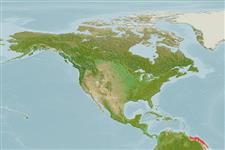Common names from other countries
Environment: milieu / climate zone / depth range / distribution range
Ecologia
; intervalo de profundidade 100 - 298 m (Ref. 271). Tropical; 14°N - 1°N, 58°W - 47°W (Ref. 4)
Western Atlantic.
Length at first maturity / Tamanho / Peso / Idade
Maturity: Lm ? range ? - ? cm Max length : 10.0 cm TL macho/indeterminado; (Ref. 271)
It has lengths of 10 cm, maximum body length; 1.6 to 3.2 cm, carapace length (Ref. 4). Occurs at depths from 120 and 298 m, but there is a record from the littoral zone, and one from 4111 to 4122 m. The bottom is variously described as "sand and coral, "sandy calcarenite", and "smooth, consisting of brown mud" (Ref. 4).
Life cycle and mating behavior
Maturidade | Reprodução | Desova | Ovos | Fecundidade | Larvas
Members of the order Decapoda are mostly gonochoric. Mating behavior: Precopulatory courtship ritual is common (through olfactory and tactile cues); usually indirect sperm transfer.
Holthuis, L.B. 1991. (Ref. 4)
Status na Lista Vermelha da IUCN (Ref. 130435)
Status no CITES (Ref. 108899)
Not Evaluated
Not Evaluated
Uso pelos humanos
Pescarias: sem interesse
| FishSource |
Ferramentas
Mais informação
Idade/Tamanho
Crescimento
Comprimento-peso
Comprimento-comprimento
Morfologia
Larvas
Abundância
Fontes da internet
Estimates based on models
Preferred temperature
(Ref.
115969): 13.6 - 18.8, mean 17.6 (based on 5 cells).
Vulnerabilidade
Low vulnerability (10 of 100).
